So you’ve set up WordPress on your website—and now you’re scratching your head… how do I log in? If you visit your site, there’s no obvious “login” button.
Fear not, here’s exactly how to login to WordPress. For almost all WordPress sites, your default login URL looks like this: yoursitename.com/wp-login.php which means adding /wp-login.php to the end of your blog’s homepage URL and hitting enter. You’ll be taken straight to your WordPress admin login page. If that doesn’t work, keep reading on for a deeper dive into getting your WordPress login situation dialed in.
As the WordPress admin, you’ll need to log in to your site in order to do things like:
- Add new posts or pages to your WordPress site.
- Update details like your contact information or About page.
- Moderate comments on your posts.
- Keep your WordPress plugins up to date.
- …and much more.
Trust me, I know… logging into your WordPress website can be a bit confusing when you’re a beginner. Don’t worry, though, it’s really easy when you know what to do. I’ll show you exactly how to log in to your WordPress admin area.
Important: These instructions are for self-hosted blogs using WordPress.org as the CMS, not for WordPress.com-managed websites. For the difference between those, check out my guide to WordPress.org vs WordPress.com.
How to Log in to WordPress Admin (Find Your WordPress Login URL)
Disclosure: Please note that some of the links below are affiliate links and at no additional cost to you, I’ll earn a commission. Know that I only recommend products and services I’ve personally used and stand behind. When you use one of my affiliate links, the company compensates me, which helps me run this blog and keep my in-depth content free of charge for readers (like you).
Want My Free Blog Business Plan Template?
Grab my free blog business plan template in both Google Doc and PDF format (that’s helped me build a six-figure blog) and reach 500,000+ monthly readers today.
Where to Find Your WordPress Login URL
When you set up WordPress, you should have received an email letting you know your WordPress login URL. But don’t worry if you can’t find that message.
For almost all WordPress sites, your login URL looks like this:
yoursitename.com/wp-login.php
So if your site’s domain name is johngrahamdaniels.com then your WordPress login is johngrahamdaniels.com/wp-login.php
If your domain name is lovelondonlovelife.com then your WordPress login is lovelondonlovelife.com/wp-login.php
If your domain name is earthmomsunited.org then your WordPress login is earthmomsunited.org/wp-login.php
I’m sure you get it! To get to your WordPress admin login page, just:
- Type the domain name of your website into your browser’s address bar
- Add /wp-login.php at the end
- Hit enter
…and you should be taken straight to your WordPress login page. It’ll look like this:
All you need to do now is enter your login details. That’s your email address (or WordPress username) along with your password.
(Note that your login credentials for your WordPress admin are not necessarily the same as your web hosting or cPanel username and password.)
If you’ve forgotten your WordPress password, use the “Lost your password?” link below the login box. This will send you an email with a special link to create a new password.
Tip: Is the login URL hard to remember? You can also get to yoursitename.com/wp-login.php by using the shorter and simpler URL yoursitename.com/login – this redirects to the login page.
Once you’ve logged in, you’ll be taken to your WordPress admin dashboard—the homepage of your WordPress admin area. The URL for this is example.com/wp-admin in most cases.
What if That WordPress Login URL Doesn’t Work? (Troubleshooting)
In a small number of cases, typing yoursitename.com/wp-login.php into your URL bar may bring up a page like this:

The login URL doesn’t work: you see an error message instead of the login screen. So what can you do next?
There are a couple of possibilities to try out here. WordPress may have been installed in a subdirectory or on a subdomain of your website.
WordPress in a Subdirectory
A subdirectory or subfolder is a folder within your website. You’ll see your website’s URL, a forward slash, then the subdirectory name.
For instance, a subdirectory might be called “blog” or “WordPress” like this:
- yoursitename.com/blog
- yoursitename.com/wordpress
If only part of your website runs on WordPress, then WordPress may be installed in a subdirectory.
In this case, your WordPress login URL will include the subdirectory. It will look something like this:
yoursitename.com/blog/wp-login.php
WordPress in a Subdomain
If you still can’t access your WordPress login page, then perhaps WordPress is installed on a subdomain.
A subdomain is another way to separate parts of a site. It goes before the URL. It might look like this:
blog.yoursitename.com
Subdomains are sometimes used for WordPress installations if several people are sharing a main domain. For instance, you might have subdomains like this:
jennifer.yoursitename.com
david.yoursitename.com
alex.yoursitename.com
If WordPress is installed on a subdomain, you need to use the whole URL of your subdomain before adding /wp-login.php, like this:
jennifer.yoursitename.com/wp-login.php
Tip: You may be able to check your site’s subdirectories and subdomains from cPanel or whatever system your web host uses for your hosting account’s admin.
Still Can’t Find Your WordPress Login URL? Get Help from Your WordPress Hosting Company
What if you’ve tried all the above options but none of them are your WordPress login URL?
It’s time to get help from your web hosting company. The support team there should be able to find your WordPress login URL for you and help you with the login process.
If you’re with Bluehost or Dreamhost (my top recommended web hosting providers), then you can find their support contact details here:
What is Your WordPress Dashboard?
Your WordPress dashboard is the page you see when you log in to WordPress. It includes quick links to key features and also has information about any recent WordPress updates.
You can customize your dashboard (and some themes show different options), but it should look something like this:
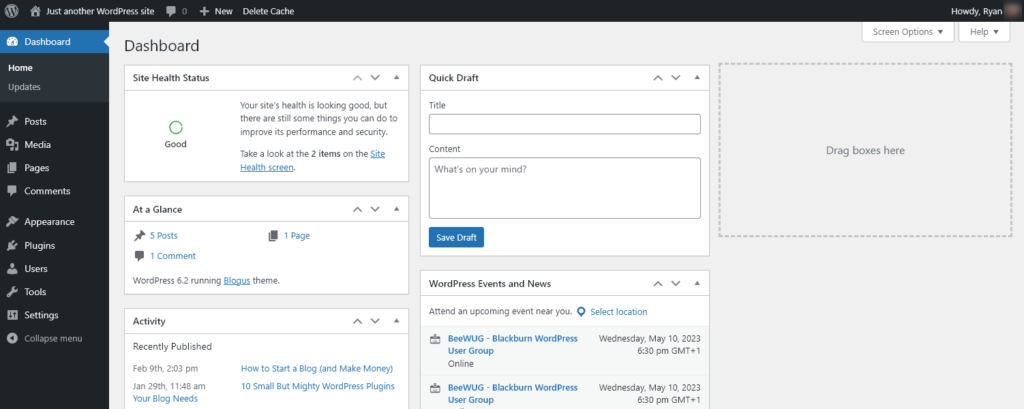
You can get back to your dashboard at any time by clicking the Dashboard link on the top right:
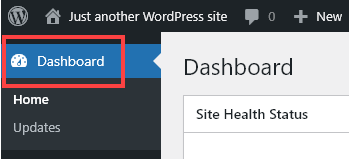
What is Your WordPress Admin Area?
Your WordPress admin area is the whole back end of your site. It’s everything you see when you’re logged in, with links to various options down the left-hand side of your screen. The admin area includes the dashboard page and every other page you can access here.
For instance, your admin area lets you add posts and pages, change your theme, install plugins, carry out maintenance tasks like updates, add new users to your site, change your WordPress settings, and much more.
Staying Logged In On WordPress (Remember Me)
It can be annoying to have to fill out the login form every single time you want to publish a blog post or make a quick change to your site.
You can get WordPress to remember you when you log in by checking the “Remember Me” box before you click the “Log In” button. That way, you’ll stay logged in on your computer.
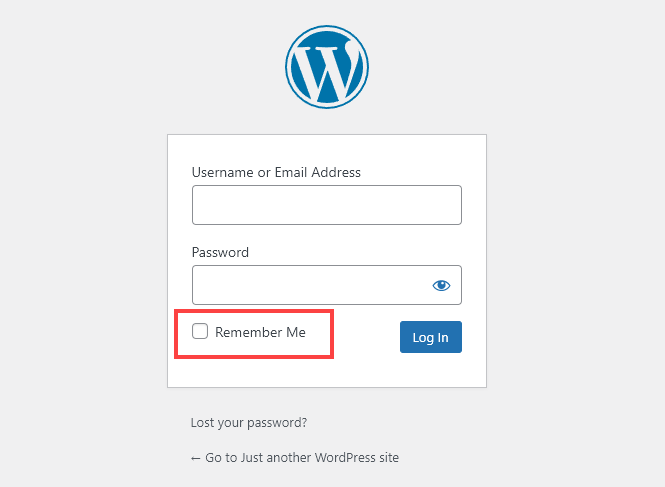
Important: Don’t use this checkbox if you’re accessing your site from a public or shared computer.
Adding a Login Link to Your WordPress Site
Maybe you’re struggling to remember your WordPress login URL. One option is to bookmark the login page on your browser. But what if other writers, editors, or assistants need to access your site?
You can add a login link to your WordPress site. The simplest way to do this is to add the built-in “Meta” widget to your sidebar or footer.
Go to Appearance→Widgets, then click the “Add Block” button for either your Sidebar Widget Area or your Footer Widget Area.
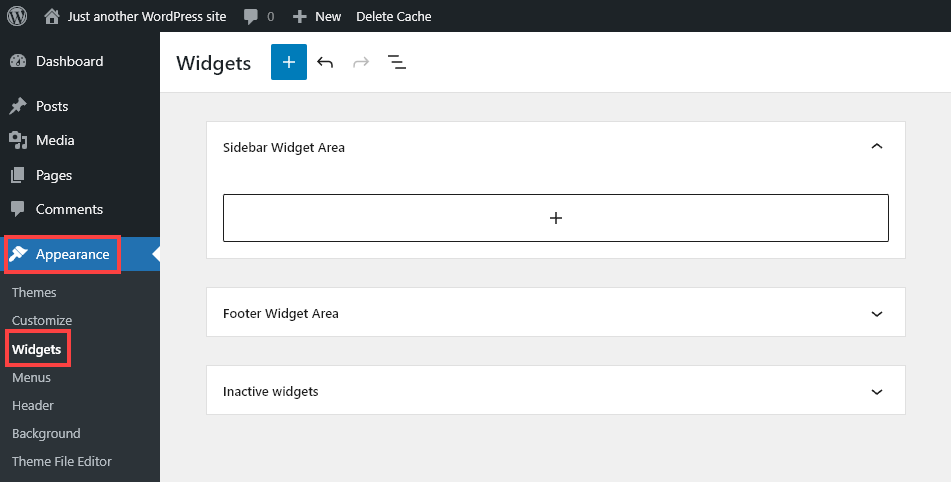
Next, select the “Meta” widget. You can do this either using the “Browse All” option or by typing /meta into the search bar.
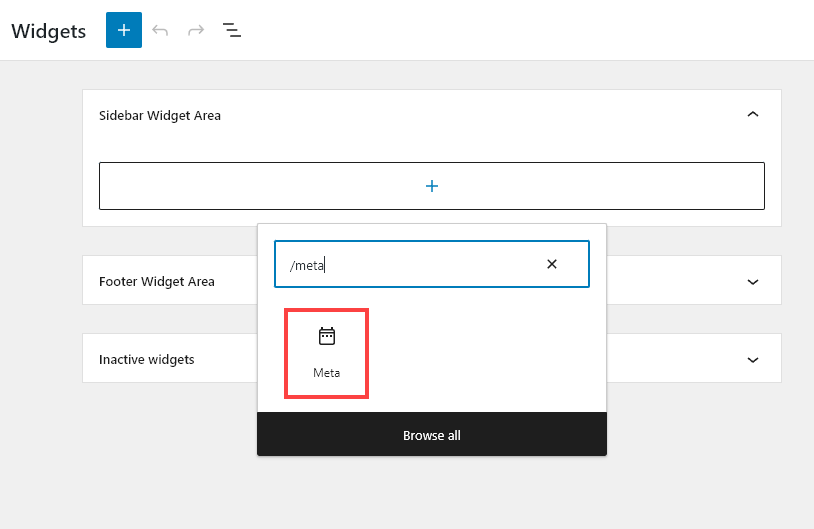
You can then give your widget a title, e.g. “Admin Links”. Make sure you hit the “Update” button on the top right to save your changes.
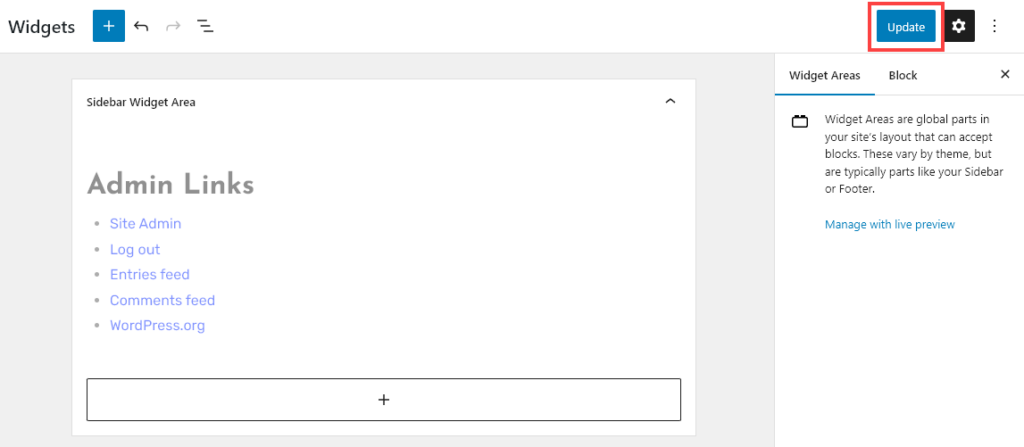
When you’re logged out, your meta widget will display like this, with the “Log in” link at the top:
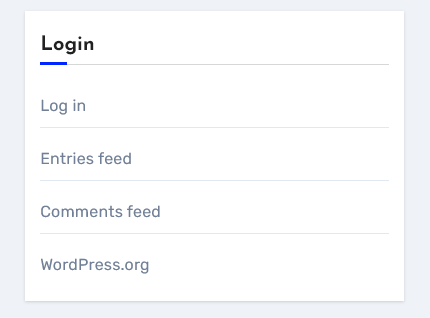
If you don’t want to have multiple different links, another option is to add a “Paragraph” widget to your sidebar or footer. Type in “Login” and make that word a link to your login page:
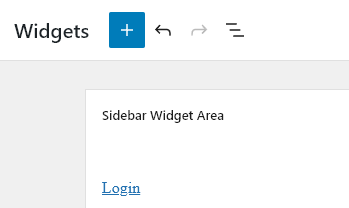
How to Log Out of WordPress (in 1 Click)
You’ve logged in … but how do you log back out again?
In many cases, it’s fine to leave your admin account logged in to WordPress. If you’re using your own computer or device, there’s generally no need to log out – especially if your computer/device is password-protected.
If you’re using a public computer or shared computer, however, it’s important for your WordPress security to log out once you’re done.
Many WordPress users get stuck trying to find the log out link. It’s not at all obvious! To get to it, you need to hover your mouse over the “Howdy, Name” link at the top right of your WordPress admin area.
You’ll then see a small dropdown menu with the “Log Out” option.
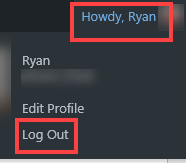
Tip: You don’t need to log out in order to see how your website looks to a regular visitor. Just use an Incognito browser window instead to view your site.
Advanced: Making Your WordPress Site More Secure
WordPress login forms can be subject to brute force attacks, where hackers try to guess your password using malicious software.
There are a few ways you can make your site more secure:
- Use 2-factor authentication for logging in.
- Block access to the login form after multiple failed login attempts.
- Make sure you’re using a secure password for LastPass, Chrome, or anywhere else your passwords are stored.
- Use a security plugin like Sucuri.
You can even take more drastic options, like limiting wp-admin access to only your own IP address, through your site’s .htaccess file.
Your site will also be more secure for both you and your users if you use an SSL certificate on your website.
You’ll Never Struggle to Find Your Dashboard Login Again
It’s easy to log in to the WordPress admin area when you know how. Just follow my tips above and you’ll be able to find your login link, access your admin WordPress page, and stay logged in when you want to.
Once you’ve successfully logged in, you might want to tackle a few different blogging tasks. I’ve got step-by-step WordPress tutorials to help you change your WordPress theme, install plugins, or generate great blog post ideas to write about.
Want My Free Blog Business Plan Template?
Grab my free blog business plan template in both Google Doc and PDF format (that’s helped me build a six-figure blog) and reach 500,000+ monthly readers today.
“*” indicates required fields








